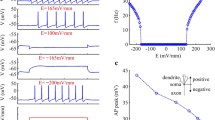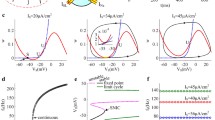Abstract
Evidence shows that the dendritic polarization induced by weak electrical field (EF) can affect the neuronal input–output function via modulating dendritic integration of AMPA synapses, indicating that the supralinear dendritic integration of NMDA synapses can also be influenced by dendritic polarization. However, it remains unknown how dendritic polarization affects NMDA-type dendritic integration, and then contributes to neuronal input–output relationship. Here, we used a computational model of pyramidal neuron with inhomogeneous extracellular potentials to characterize the relationship among EF, dendritic integration, and somatic output. Basing on singular perturbation we analyzed the subthreshold dynamics of membrane potentials in response to NMDA synapses, and found that the equilibrium mapping of a fast subsystem can characterize the asymptotic subthreshold input–output (sI/O) relationship for EF-regulated supralinear dendritic integration, allowing us to predict the tendency of EF-regulated dendritic integration by showing the variation of equilibrium mapping under EF stimulation. EF-induced depolarization at distal dendrites receiving synapses plays a crucial role in shifting the steep change of sI/O left by facilitating dendritic NMDA spike generation and in decreasing the plateau of sI/O via reducing driving force. And more effective EF modulation appears at sparsely activated NMDA receptors compared with clustered synaptic inputs. During the action potential (AP) generation, the respective contribution of EF-regulated dendritic integration and EF-induced somatic polarization was identified to show their synergetic or antagonistic effect on AP generation, depending on neuronal excitability. These results provided insight in understanding the modulation effect of EF on neuronal computation, which is important for optimizing noninvasive brain stimulation.





Similar content being viewed by others
Data availability
All data generated or analysed during this study are included in this published article and Supplementary Information.
Code availability
Custom code is available upon reasonable request.
References
Akiyama H, Shimizu Y, Miyakawa H, Inoue M (2011) Extracellular DC electric fields induce nonuniform membrane polarization in rat hippocampal CA1 pyramidal neurons. Brain Res 1383:22–35. https://doi.org/10.1016/j.brainres.2011.01.097
Augusto E, Gambino F (2019) Can NMDA spikes dictate computations of local networks and behavior? Front Mol Neurosci 12:238. https://doi.org/10.3389/fnmol.2019.00238
Berzhanskaya J, Chernyy N, Gluckman BJ, Schiff SJ, Ascoli GA (2013) Modulation of hippocampal rhythms by subthreshold electric fields and network topology. J Comput Neurosci 34(3):369–389. https://doi.org/10.1007/s10827-012-0426-4
Bikson M, Inoue M, Akiyama H, Deans JK et al (2004) Effects of uniform extracellular DC electric fields on excitability in rat hippocampal slices in vitro. J Physiol 557(1):175–190. https://doi.org/10.1113/jphysiol.2003.055772
Bittner KC, Grienberger C, Vaidya SP, Milstein AD, Suh J et al (2015) Conjunctive input processing drives feature selectivity in hippocampal CA1 neurons. Nat Neurosci 18:1133–1142. https://doi.org/10.1038/nn.4062
Branco T, Clark BA, Häusser M (2010) Dendritic discrimination of temporal input sequences in cortical neurons. Science 329:1671–1675. https://doi.org/10.1126/science.1189664
Cavarretta F, Carnevale NT, Tegolo D (2014) Effects of low frequency electric fields on synaptic integration in hippocampal CA1 pyramidal neurons: implications for power line emissions. Front Cell Neurosci 8:310. https://doi.org/10.3389/fncel.2014.00310
Chakraborty D, Truong DQ, Bikson M, Kaphzan H (2018) Neuromodulation of axon terminals. Cereb Cortex 28(8):2789–2794. https://doi.org/10.1093/cercor/bhx158
Cichon J, Gan WB (2015) Branch-specific dendritic Ca2+ spikes cause persistent synaptic plasticity. Nature 520:180–185. https://doi.org/10.1038/nature14251
Deans JK, Powell AD, Jefferys JGR (2007) Sensitivity of coherent oscillations in rat hippocampus to AC electric fields. J Physiol 583(2):555–565. https://doi.org/10.1113/jphysiol.2007.137711
Dyhrfjeld-Johnsen J, Morgan RJ, Földy C, Soltesz I (2008) Upregulated H current in hyperexcitable CA1 dendrites after febrile seizures. Front Cell Neurosci 2:2. https://doi.org/10.3389/neuro.03.002.2008
Fan YQ, Wei XL, Yi GS et al (2021) Asymptotic input-output relationship predicts electric field effect on sublinear dendritic integration of AMPA synapses. Neural Comput 33(11):3102–3138. https://doi.org/10.1162/neco_a_01438
Gambino F, Pagès S, Kehayas V, Baptista D, Tatti R, Carleton A et al (2014) Sensory-evoked LTP driven by dendritic plateau potentials in vivo. Nature 515:116–119. https://doi.org/10.1038/nature13664
Golding NL, Staff NP, Spruston N (2002) Dendritic spikes as a mechanism for cooperative long-term potentiation. Nature 418:326–331. https://doi.org/10.1038/nature00854
Hao J, Oertner TG (2012) Depolarization gates spine calcium transients and spike-timing-dependent potentiation. Curr Opin Neurobiol 22:509–515. https://doi.org/10.1016/j.conb.2011.10.004
Jackson MP, Rahman A, Lafon B, Kronberg G et al (2016) Animal models of transcranial direct current stimulation: methods and mechanisms. Clin Neurophysiol 127(11):3425–3454. https://doi.org/10.1016/j.clinph.2016.08.016
Kronberg G, Bridi M, Abel T, Bikson M, Parra LC (2017) Direct current stimulation modulates LTP and LTD: activity dependence and dendritic effects. Brain Stimul 10(1):51–58. https://doi.org/10.1016/j.brs.2016.10.001
Lafon B, Rahman A, Bikson M, Parra LC (2017) Direct current stimulation alters neuronal input/output function. Brain Stimul 10(1):36–45. https://doi.org/10.1016/j.brs.2016.08.014
Larkum ME, Nevian T, Sandler M, Polsky A, Schiller J (2009) Synaptic integration in tuft dendrites of layer 5 pyramidal neurons: a new unifying principle. Science 325(5941):756–760. https://doi.org/10.1126/science.1171958
Lavzin M, Rapoport S, Polsky A, Garion L, Schiller J (2012) Nonlinear dendritic processing determines angular tuning of barrel cortex neurons in vivo. Nature 490(7420):397–401. https://doi.org/10.1038/nature11451
Lisman J, Spruston N (2005) Postsynaptic depolarization requirements for LTP and LTD: a critique of spike timing-dependent plasticity. Nat Neurosci 8:839–841. https://doi.org/10.1038/nn0705-839
Major G, Polsky A, Denk W, Schiller J, Tank DW (2008) Spatiotemporally graded NMDA spike/plateau potentials in basal dendrites of neocortical pyramidal neurons. J Neurophysiol 99:2584–2601. https://doi.org/10.1152/jn.00011.2008
Major G, Larkum ME, Schiller J (2013) Active properties of neocortical pyramidal neuron dendrites. Annu Rev Neurosci 36:1–24. https://doi.org/10.1146/annurev-neuro-062111-150343
Morya E, Monte-Silva K, Bikson M, Esmaeilpour Z et al (2019) Beyond the target area: an integrative view of tDCS-induced motor cortex modulation in patients and athletes. J Neuroeng Rehabil 16(1):141. https://doi.org/10.1186/s12984-019-0581-1
Nitsche MA, Schauenburg A, Lang N, Liebetanz D, Exner C, Paulus W et al (2003) Facilitation of implicit motor learning by weak transcranial direct current stimulation of the primary motor cortex in the human. J Cogn Neurosci 15(4):619–626. https://doi.org/10.1162/089892903321662994
Poleg-Polsky A (2015) Effects of neural morphology and input distribution on synaptic processing by global and focal NMDA-spikes. PLoS ONE 10(10):e0140254. https://doi.org/10.1371/journal.pone.0140254
Poolos NP, Migliore M, Johnston D (2002) Pharmacological upregulation of h channels reduces the excitability of pyramidal neuron dendrites. Nat Neurosci 5(8):767–774. https://doi.org/10.1007/s10827-012-0426-4
Radman T, Su Y, An JH, Bikson M (2007) Spike timing amplifies the effect of electric fields on neurons: implications for endogenous field effects. J Neurosci 27(11):3030–3036. https://doi.org/10.1523/jneurosci.0095-07.2007
Radman T, Ramos RL, Brumberg JC, Bikson M (2009) Role of cortical cell type and morphology in sub- and suprathreshold uniform electric field stimulation. Brain Stimul 2(4):215–228. https://doi.org/10.1016/j.brs.2009.03.007
Rahman A, Reato D, Arlotti M, Gasca F et al (2013) Cellular effects of acute direct current stimulation: somatic and synaptic terminal effects. J Physiol 591(10):2563–2578. https://doi.org/10.1113/jphysiol.2012.247171
Sabatini B, Oertner T, Svoboda K (2002) The life cycle of Ca2+ ions in dendritic spines. Neuron 33:439–452. https://doi.org/10.1016/s0896-6273(02)00573-1
Schiller J, Major G, Koester HJ, Schiller Y (2000) NMDA spikes in basal dendrites of cortical pyramidal neurons. Nature 404(6775):285–289. https://doi.org/10.1038/35005094
Simonsmeier BA, Grabner RH, Hein J, Krenz U, Schneider M (2018) Electrical brain stimulation (tES) improves learning more than performance: a meta-analysis. Neurosci Biobehav Rev 84:171–181. https://doi.org/10.1016/j.neubiorev.2017.11.001
Sjöström PJ, Häusser M (2006) A cooperative switch determines the sign of synaptic plasticity in distal dendrites of neocortical pyramidal neurons. Neuron 51:227–238. https://doi.org/10.1016/j.neuron.2006.06.017
Tran-Van-Minh A, Cazé RD, Abrahamsson T, Cathala L et al (2015) Contribution of sublinear and supralinear dendritic integration to neuronal computations. Front Cell Neurosci 9:67. https://doi.org/10.3389/fncel.2015.00067
Tsodyks M, Kenet T, Grinvald A, Arieli A (1999) Linking spontaneous activity of single cortical neurons and the underlying functional architecture. Science 286:1943–1946. https://doi.org/10.1126/science
Williams SR, Stuart GJ (2002) Dependence of EPSP efficacy on synapse location in neocortical pyramidal neurons. Science 295(5561):1907–1910. https://doi.org/10.1126/science.1067903
Wu T, Fan J, Lee KS, Li X (2016) Cortical neuron activation induced by electromagnetic stimulation: a quantitative analysis via modelling and simulation. J Comput Neurosci 40:51–64. https://doi.org/10.1007/s10827-015-0585-1
Yi GS, Wang J, Deng B, Wei XL (2017) Morphology controls how hippocampal CA1 pyramidal neuron responds to uniform electric fields: a biophysical modeling study. Sci Rep 7(1):3210. https://doi.org/10.1038/s41598-017-03547-6
Yi GS, Wei XL, Wang J, Deng B, Che YQ (2019) Modulations of dendritic Ca2+ spike with weak electric fields in layer 5 pyramidal cells. Neural Netw 110:8–18. https://doi.org/10.1016/j.neunet.2018.10.013
Acknowledgements
This work was supported by the National Natural Science Foundation of China under Grant 62171312, 62071324, and the Tianjin Municipal Natural Science Foundation under Grant 19JCQNJC01200.
Funding
This study was funded by the National Natural Science Foundation of China under Grant 62171312, 62071324, and the Tianjin Municipal Natural Science Foundation under Grant 19JCQNJC01200.
Author information
Authors and Affiliations
Contributions
All authors contributed to the study conception and design. Material preparation, data collection and analysis were performed by YF. The first draft of the manuscript was written by YF and all authors commented on previous versions of the manuscript. All authors read and approved the final manuscript.
Corresponding author
Ethics declarations
Conflict of interest
The authors declare they have no financial interests.
Consent to participate
All authors expressed written consent to participate in the research.
Ethical approval
This research doesn’t contain ethical issues.
Additional information
Publisher's Note
Springer Nature remains neutral with regard to jurisdictional claims in published maps and institutional affiliations.
Supplementary Information
Below is the link to the electronic supplementary material.
11571_2022_9922_MOESM1_ESM.docx
S1 File: In section 1, we introduced the detailed parameters of SCM-PYN-NMDA with S1 Table. In section 2, we introduced the detailed parameters of active ionic currents of a biophysical layer 5 pyramidal neuron with S2 Table. In section 3, we introduced the detailed parameters of multi current clamp stimulation used to mimic EF stimulations in different cases with S3 Table, S4 Table, S5 Table, S6 Table. (DOCX 68 kb)
11571_2022_9922_MOESM2_ESM.docx
S2 File: The detail derivation process about how to analyze and obtain the equilibrium point of SCM-PYN-NMDA. (DOCX 187 kb)
Rights and permissions
Springer Nature or its licensor (e.g. a society or other partner) holds exclusive rights to this article under a publishing agreement with the author(s) or other rightsholder(s); author self-archiving of the accepted manuscript version of this article is solely governed by the terms of such publishing agreement and applicable law.
About this article
Cite this article
Fan, Y., Wei, X., Lu, M. et al. Electric field effects on neuronal input–output relationship by regulating NMDA spikes. Cogn Neurodyn 18, 199–215 (2024). https://doi.org/10.1007/s11571-022-09922-y
Received:
Revised:
Accepted:
Published:
Issue Date:
DOI: https://doi.org/10.1007/s11571-022-09922-y




